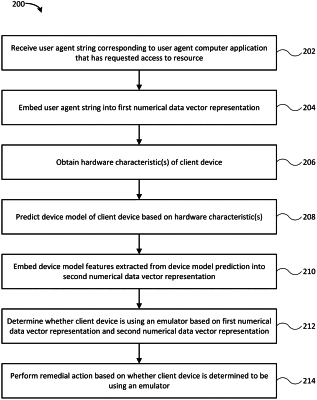| CPC G06F 21/566 (2013.01) [G06F 18/2148 (2023.01); G06F 18/2413 (2023.01); G06F 40/205 (2020.01); G06F 2221/034 (2013.01)] | 20 Claims |

|
1. A computer system comprising:
a non-transitory memory storing instructions; and
one or more hardware processors configured to read the instructions and cause the computer system to perform operations comprising:
receiving, from a client device, a user agent string corresponding to a user agent computer application that has requested access to a resource associated with the computer system;
embedding the user agent string into a first numerical data vector representation of the user agent computer application;
obtaining, from the client device, one or more hardware characteristics of the client device;
predicting a device model for the client device based on the one or more hardware characteristics;
embedding device model features extracted from the device model prediction into a second numerical data vector representation; and
determining whether the client device is using an emulator based on the first numerical data vector representation and the second numerical data vector representation.
|